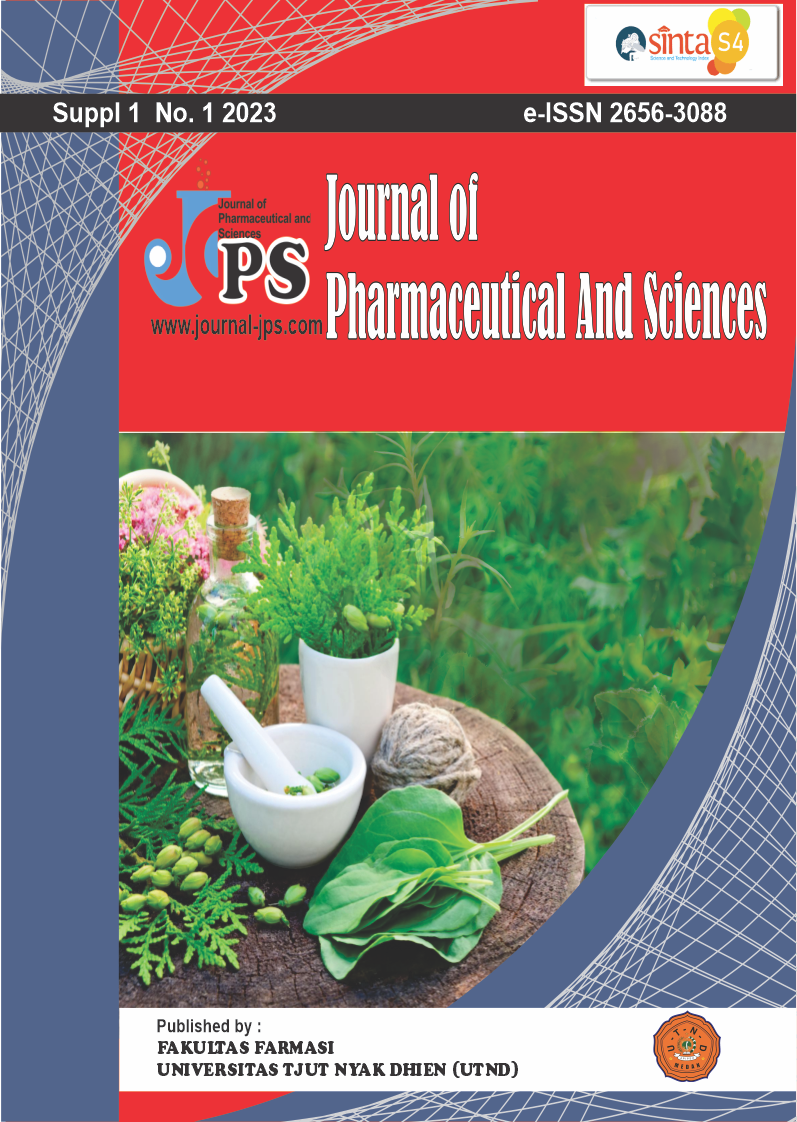Polyherbal lotion preparation formulation of avocado oil (Persea americana) and celery extract (Apium graveolens L) as a skin moisturiser
Main Article Content
Page: 375-384
Abstract
Background: avocado oil contains vitamins A, D, E and lecithin. This content is efficacious to moisturise and regenerate the skin, and it is a natural sunscreen that protects the skin from UV rays. The flavonoid content in celery can neutralise free radicals and prevent premature aging. Then, this plant can be processed and used as a cosmetic preparation in the form of lotion. Polyherbs are cosmetic products that contain one or more herbal substances. This study aimed to determine whether avocado oil (Apium graveolens L) and celery (Persea americana) in polyherbal lotion preparation extracts can provide skin moisture. Methods: the method used is experimental by making celery extraction by maceration using 96% ethanol solvent and concentrated with a rotary evaporator and avocado oil as a combination lotion preparation of 1.5%, 2%, 2.5% and 3% concentrations. As blanks used lotion base. Tests on lotion preparations include homogeneity tests, pH measurements, determination of emulsion type, stability, irritation to volunteers, liking/hedonics, moisture effectiveness compared with existing preparations, using the Skin Analyzer Detector tool, and antioxidant activity tests. Result: the results of the study showed that all lotion preparations were homogeneous, had a pH of 6.2-5.9, emulsion type M/A and were stable during storage of 4 weeks. Lotion preparations of avocado oil and celery extract with a concentration of 3% can provide the best moisturising effect on the skin after 4 weeks. All polyherbal lotion preparations of avocado oil and celery extract do not irritate the skin; celery ethanol extract and avocado oil have antioxidant activity in the "medium" category with an IC50 value of 143 ppm. Polyherbal lotion preparations with a concentration of 3% show effectiveness as the best moisturiser.
Downloads
Article Details

This work is licensed under a Creative Commons Attribution-NonCommercial-ShareAlike 4.0 International License.
References
Aprilliani, A., Supriyanta, J., & Badriah, L. (2022). Formulasi Dan Uji Efektivitas Antioksidan Handbody Lotion Ekstrak Etanol 70% Buah Mentimun (Cucumis sativus L) Dengan Metode DPPH. Jurnal Farmagazine, 9(1), 1-9.
Aramo, (2012). Skin And Hair Diagnosis System. Sungnam: Aram Huvis Korea L. Td. Page. 1-10.
Butarbutar M, Chaerunisaa A.(2021) Peran Pelembab dalam Mengatasi Kondisi Kulit Kering. Majalah Farmasetika.; 6(1):56–69.
Chan, A. (2017). Formulasi sediaan sabun mandi padat dari ekstrak buah apel (Malus domesticus) sebagai sabun kecantikan kulit. Jurnal Ilmiah Manuntung. 2(1).51-55.
Dewi, E. A. (2021). Potensi Platelet Rich Plasma (PRP) Untuk Kecantikan Alami. Jurnal Tadris IPA Indonesia, 1(3), 385-393.
Dominica, D., & Handayani, D. (2019). Formulasi dan Evaluasi Sediaan Lotion dari ekstrak daun lengkeng (Dimocarpus longan) sebagai Antioksidan. Jurnal Farmasi dan ilmu kefarmasian Indonesia. 6(1). 1-7.
Gupta, S. K., Singhal, P., Singh, A., Chauhan, R., & Kumar, B. (2018). Nutritional and pharmceutical benifits of avocado plant. Journal of Advanced Scientific Research, 9(02), 4-11..
Handoyo, D. L. (2020). Pengaruh Lama Waktu Maserasi (Perendaman) Terhadap Kekentalan Ekstrak Daun Sirih (Piper betle). Jurnal Farmasi Tinctura, 2(1), 34-41.
Hepni, H. (2021). Formulasi Sediaan Lotion Menggunakan Kolagen Tulang Ikan Patin (Pangasius SP) Sebagai Pelembab Kulit. Indonesian Trust Health Journal, 4(1), 401-408.
Husni, P., Ruspriyani, Y., & Hasanah, U. (2021). Formulasi Dan Uji Stabilitas Sediaan Lotion Ekstrak Kering Kulit Kayu Manis (Cinnamomum burmannii). Jurnal Sabdariffarma, 9(2), 1-7.
Iskandar, B., Sidabutar, S. E., & Leny. (2021). Formulasi dan Evaluasi Lotion Ekstrak Alpukat (Persea americana) Sebagai Pelembab Kulit. J.Islamic Pharm., 6(1), 14-21.
Karim, N., Arisanty, & Pakadang, R. S. (2022). Formulasi Dan Uji Stabilitas Sediaan Lotion Ekstrak Air Buah Tomat (Solanum lycopersicum L). AKFARINDO, 7(2), 100-107.
Lin, T. K., Zhong, L., & Santiago, J. L. (2017). Anti-inflammatory and skin barrier repair effects of topical application of some plant oils. International journal of molecular sciences, 19(1), 70.
Maimunah, S., Nasution, Z., Farmasi, F., Sari, U., & Indonesia, M. (2020). Pemanfaatan Ekstrak Daun Urtica Dioica L. Sebagai Anti-Aging Alami Dalam Sediaan Krim. Jurnal Penelitian Saintek, 25(2), 124–134.
Mohiudin, AK. (2019). Skin care : Formulation and use. American journal of dermatological research and reviews. 2 (8).
Ordu, J. I., & Jaja, G. O. (2018). Evaluation of Pulp Oil Persea Americana (Avocado Fruit) in Pharmaceutical Cream Formulation. International J of Advances in Scientific Research and Engineering, 4(5), 14-25.
Rosaini, H., Makmur, I., Putri, R. D., & Sidoretno, W. M. (2019). Formulasi, Pengujian Antioksidan dan Antibakteri Sediaan Masker Gel Peel Off Ekstrak Etanol Herba Seledri (Apium graveolens L). Farmasi Higea, 11(2), 133-143.
Rusdiana, T. (2018). Telaah Tanaman Seledri (Apium graveolens L) Sebagai Sumber Bahan Alam Berpotensi Tinggi Dalam Upaya Promotif Kesehatan. Indonesia Natural Research Pharmaceutical Journal, 3(1), 1-8.
Saudagar, R. B., & Sisodiya, M. H. (2018). Review on herbal cosmetics. World Journal of Pharmaceutical Research, 7(7), 573-591.
Sulastri, L., Rizikiyan, Y., Indryati, S., Amelia, R., Karlina, N. (2022). Formulasi dan Uji Aktivitas Antioksidan Lotion Sari Wortel (Daucus carota L.) dengan Metode DPPH (2, 2-diphenyl- 1-picrylhydrazyl). Journal of Pharmacopolium. 4(3).
Tazkya, M. (2022). Formulasi Dan Uji Stabilitas Fisik Hand Body Lotion Halal Dari Ekstrak Rimpang Kunyit (Curcuma longa).
Turnip, N. M. (2022). Seminar Pembuatan Sediaan Cair Dari Ekstrak Daun Seledri (Apium graveolens L) Untuk Melembabkan Kulit. Pengabdian Kepada Masyarakat, 2(1), 1-5.





